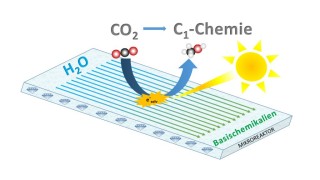
Fraunhofer ICT-IMM is coordinating a national research cooperation dealing with the development of a microreactor system for the environmentally friendly utilization of CO2 by means of sunlight.
Carbon dioxide (CO2), methane and oxides of nitrogen – all of them greenhouse gases being in the line of fire when searching for the contributors to global warming. With more than three-quarters CO2 represents the most significant part of the emission. Although the carbon cycle is almost closed when using bio mass for energy generation, the utilization of generated CO2 is a highly topical sociopolitical question. In case of a successful utilization, especially when applying alternative sources of energy such as wind energy, hydrodynamic power or solar energy, the eco-balance can sustainably be improved.
Nature as paradigm
In the course of the project CarbonCat important findings are expected to properly address this question. Doing so, high-power LEDs will be used in combination with the targeted conversion of CO2 relying on a novel, predominantly carbon-based catalyst system. This catalyst system is supposed to be applied in a micro structured reaction environment. At long sight the consortium, made up of the Fraunhofer ICT-IMM, the Julius-Maximilians-Universität Würzburg and the company Sahlmann Photochemical Solutions, technologically aims at coming as close as possible to nature inspired photosynthesis while exclusively using sunlight.
“This pioneering project allows us to recreate the natural photosynthesis process in a technical system. Instead of plant cells with their photosynthetically active chloroplasts we will use a newly developed micro reactor containing the diamond photocatalyst as photoactive center. The special construction of the micro reactor allows a continuous mixing of CO2 and water under radiation with visible light”, explains Thomas Rehm, Senior Scientist at Fraunhofer ICT-IMM and coordinator of the research project.
Innovative catalyst system put in the right light
The project CarbonCat is supposed to prove that it is possible to convert CO2 into valuable chemical C1 components such as methanol under near-natural conditions. For Anke Krüger, professor of Organic Chemistry at Julius-Maximilians-Universität Würzburg this means that “besides the technological part of the work the chemical optimization of diamond as a photocatalyst will be playing a key role. The selective functionalization of diamond surfaces with complex organic compounds is anything but simple, especially with respect to the long-term stability when being used in a continuous process as we intend to apply in the micro reactor.”
In addition to the reactor technology and the catalytically active surfaces the selection and the adequate mixing of the required wavelengths as well as the arrangement of the LEDs are of vital importance. “The interaction between the light source and the other system components deserves the greatest attention. This is as relevant for the photocatalytic process as for the overall efficiency of the reactor”, predicts Benjamin Sahlmann, working as a freelance chemist under the name of Sahlmann Photochemical Solutions.
“With the knowledge gained from CarbonCat we hope to be able to contribute to minimizing the environmental impact resulting from existing CO2 emissions not too far in the future”, concludes Thomas Rehm.
The national joint research project CarbonCat is funded by the Federal Ministry of Education and Research under the support measure “CO2 Plus”. The project partners will receive a funding of 1.34 million € for a period of three years.
Contribution of the project partners
Based on its expertise in the development and exploration of micro structured reactors Fraunhofer ICT-IMM will realize a continuously operating reactor plant whose core will be the novel diamond photocatalyst. The physical adaptation of the diamond material applied in the micro reactor as well as the detailed investigation of the photocatalytic process in continuous operation mode also is part of ICT-IMM’s tasks.
Professor Krüger’s research group at the Julius-Maximilians-Universität Würzburg is dealing with the fabrication, characterization and application of nano scale carbon-based materials, especially diamond, for more than 10 years. CarbonCat will make use of the methods to establish an exceptionally stable link of functional molecules at diamond surfaces which have been developed by the research group. These methods will help to optimize the diamond material for its use as photocatalyst in the micro reactor.
Sahlmann Photochemical Solutions will develop the light sources required for the photocatalysis in the reactor system within the CarbonCat project. The tailor-made fabrication of the required light sources, their spectral measurement as well as their evaluation to ensure safety in the workplace is part of the tasks.
Source
Fraunhofer ICT-IMM, press release, 2016-09-15.
Supplier
Bundesministerium für Bildung und Forschung (BMBF)
Fraunhofer-Institut für Chemische Technologie (ICT)
Fraunhofer-Institut ICT-IMM
Sahlmann Photochemical Solutions
Universität Würzburg
Share
Renewable Carbon News – Daily Newsletter
Subscribe to our daily email newsletter – the world's leading newsletter on renewable materials and chemicals










